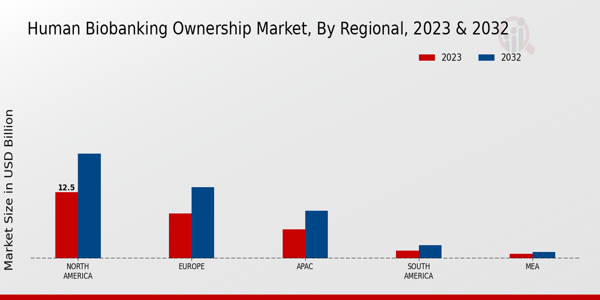Market Growth Projections
The Global Human Biobanking Ownership Market Industry is poised for substantial growth, with projections indicating a market value of 31.9 USD Billion in 2024 and an anticipated increase to 54.7 USD Billion by 2035. This growth trajectory reflects a compound annual growth rate of 5.02% from 2025 to 2035, suggesting a robust expansion driven by various factors, including technological advancements, increased government support, and rising demand for personalized medicine. The market's evolution is likely to be influenced by ongoing research initiatives and the growing recognition of biobanks as vital resources for scientific inquiry.
Growing Awareness of Rare Diseases
The Global Human Biobanking Ownership Market Industry is significantly impacted by the rising awareness and research focus on rare diseases. As healthcare stakeholders recognize the need for comprehensive data on these conditions, biobanks become essential for collecting and analyzing biological samples from affected individuals. This trend not only facilitates the development of targeted therapies but also enhances understanding of disease mechanisms. The increasing prevalence of rare diseases, coupled with the growing number of biobanks dedicated to this purpose, suggests a promising future for the industry. The market's expansion aligns with the overall growth trajectory, potentially reaching 54.7 USD Billion by 2035.
Rising Demand for Personalized Medicine
The Global Human Biobanking Ownership Market Industry experiences a notable surge in demand for personalized medicine, driven by advancements in genomics and biotechnology. As healthcare shifts towards tailored treatments, biobanks play a crucial role in providing the necessary biological samples for research and development. This trend is underscored by the projected market value of 31.9 USD Billion in 2024, reflecting the increasing investment in biobanking infrastructures. Furthermore, the anticipated growth to 54.7 USD Billion by 2035 indicates a robust compound annual growth rate of 5.02% from 2025 to 2035, highlighting the industry's pivotal role in the evolution of healthcare.
Increased Government Funding and Support
Government initiatives and funding play a vital role in shaping the Global Human Biobanking Ownership Market Industry. Various governments are recognizing the importance of biobanks in advancing medical research and public health. Increased funding for biobanking projects facilitates the establishment and maintenance of biobanks, thereby enhancing their capacity to support research endeavors. This support is reflected in the growing number of biobanks worldwide, which are essential for collecting and storing biological samples. As governments continue to prioritize biobanking, the industry is likely to witness sustained growth, contributing to the projected market value increase to 54.7 USD Billion by 2035.
Technological Advancements in Biobanking
Technological innovations significantly influence the Global Human Biobanking Ownership Market Industry, enhancing the efficiency and effectiveness of biobanking operations. Advanced storage solutions, automated sample processing, and sophisticated data management systems streamline biobanking processes, ensuring high-quality sample preservation and retrieval. These advancements not only improve operational efficiency but also expand the scope of research possibilities. As a result, biobanks are increasingly viewed as essential resources for researchers, potentially driving market growth. The integration of cutting-edge technologies appears to be a key factor in the industry's expansion, aligning with the projected market growth trajectory.
Ethical Considerations and Regulatory Frameworks
Ethical considerations and regulatory frameworks are critical drivers of the Global Human Biobanking Ownership Market Industry. As biobanks collect and store human biological materials, adherence to ethical standards and regulations is paramount. This focus on ethics ensures public trust and encourages participation in biobanking initiatives. Regulatory bodies are increasingly establishing guidelines that govern biobanking practices, which can enhance the credibility and reliability of biobanks. Consequently, this regulatory environment may foster growth in the industry, as compliance with ethical standards is likely to attract more researchers and institutions to utilize biobanking resources.























